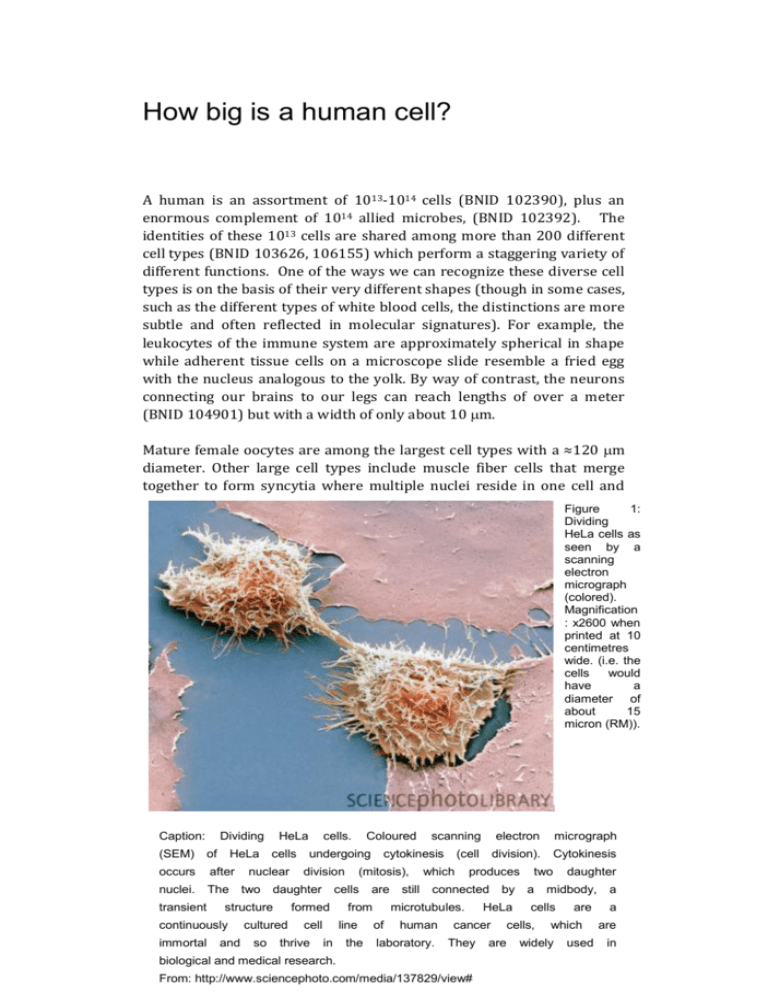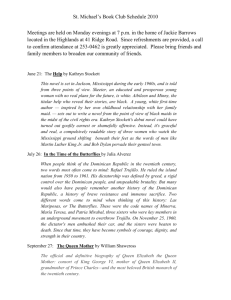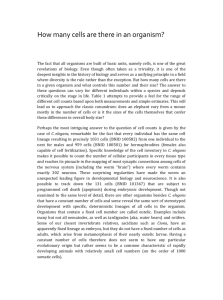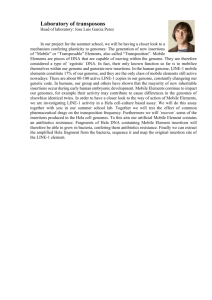How big is a human cell? - Weizmann Institute of Science
advertisement

How big is a human cell? A human is an assortment of 1013-1014 cells (BNID 102390), plus an enormous complement of 1014 allied microbes, (BNID 102392). The identities of these 1013 cells are shared among more than 200 different cell types (BNID 103626, 106155) which perform a staggering variety of different functions. One of the ways we can recognize these diverse cell types is on the basis of their very different shapes (though in some cases, such as the different types of white blood cells, the distinctions are more subtle and often reflected in molecular signatures). For example, the leukocytes of the immune system are approximately spherical in shape while adherent tissue cells on a microscope slide resemble a fried egg with the nucleus analogous to the yolk. By way of contrast, the neurons connecting our brains to our legs can reach lengths of over a meter (BNID 104901) but with a width of only about 10 m. Mature female oocytes are among the largest cell types with a ≈120 m diameter. Other large cell types include muscle fiber cells that merge together to form syncytia where multiple nuclei reside in one cell and Figure 1: Dividing HeLa cells as seen by a scanning electron micrograph (colored). Magnification : x2600 when printed at 10 centimetres wide. (i.e. the cells would have a diameter of about 15 micron (RM)). Caption: Dividing HeLa Coloured (SEM) of occurs after nuclei. The two daughter cells transient HeLa cells cells. structure continuously immortal nuclear and formed cultured so undergoing division cell thrive cytokinesis (mitosis), are still from line in the scanning (cell which micrograph division). Cytokinesis produces two daughter connected by a midbody, microtubules. of electron human laboratory. HeLa cancer They biological and medical research. From: http://www.sciencephoto.com/media/137829/view# are cells cells, are which widely used a a are in megakaryocytes, bone marrow cells responsible for the production of blood platelets. Both of these cell types can reach 40 m in diameter (BNID 105114). Red blood cells, also known as erythrocytes, are some of the smallest of human cells. These cells have a characteristic biconcave disk shape with a depression where the nucleus was lost in maturation and have a corresponding diameter of 7-8 m (BNID 100509) and a volume of ≈100 m3 (BNID 101711, 101713). Certain human cell lines have been domesticated as laboratory workhorses. Perhaps the most familiar of all are the so-called HeLa cells (see Fig. 1), immortal cancer cell lines that divide indefinitely, alleviating the need to sacrifice primary animal tissue for experiments. These cells lines have been used for studies such as the molecular basis of signal transduction and the cell cycle. In these cell types, the cell volumes are captured by a “rule of thumb” value of 2000 m3 with a range of 5004000 m3 (BNID 100434), with these numbers coming from studies of cell lines such as the HeLa cells introduced above. HeLa cells adhere to the extracellular matrix and like many other cell types on a microscope slide spread thinly to a diameter of ≈40 m (BNID 103718, 105877, 105878) but only a few m in height. When grown to confluence they press on each other to compact the diameter to ≈20 m such that in one of the wells of a 96 multiwell plate they create a monolayer of ≈100,000 cells. Tighter bounds were put on the variability of a given cell type by a careful analysis of a mouse lymphocyte cell line as shown in fig. 2. The distribution is centered at about 1000 m3 with a variance of about 300 m3. To put these cellular sizes in perspective, if we think of E. coli as having the size of a human being, then a HeLa cell is about the size of a blue whale. Our examination of the sizes of different cell types will serve as a jumping off point for developing intuition for a variety of other biological numbers we will encounter throughout the book. For example, when thinking about diffusion we will interest ourselves in the time scale for Figure 2: Distribution of cell sizes for L1210, a mouse lymphoblast cell line. The cell volumes are reported in units of fL (1 fL = 1 m3). Figure from Tzur et al. Science 2010 particular molecules to traverse a given cell type and this result depends in turn upon the size of those cells.







